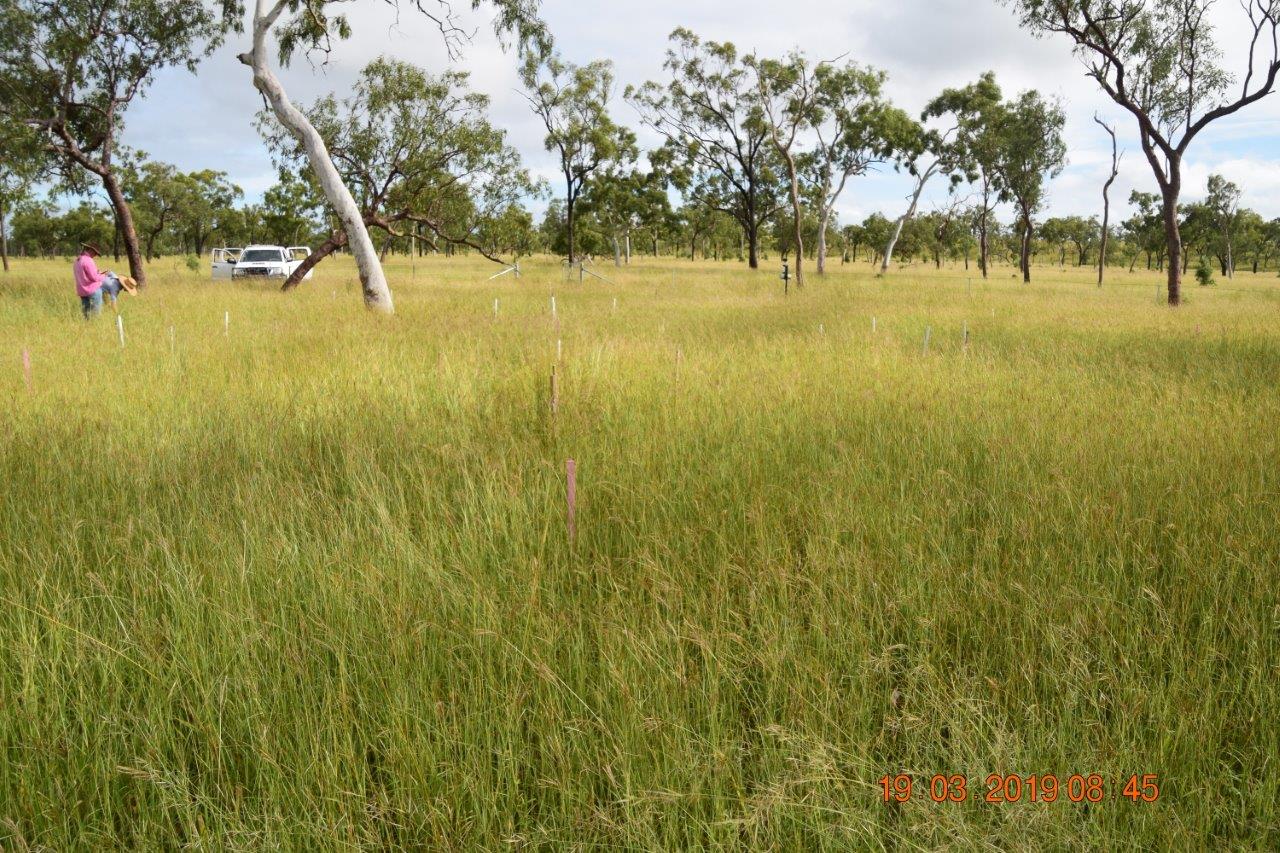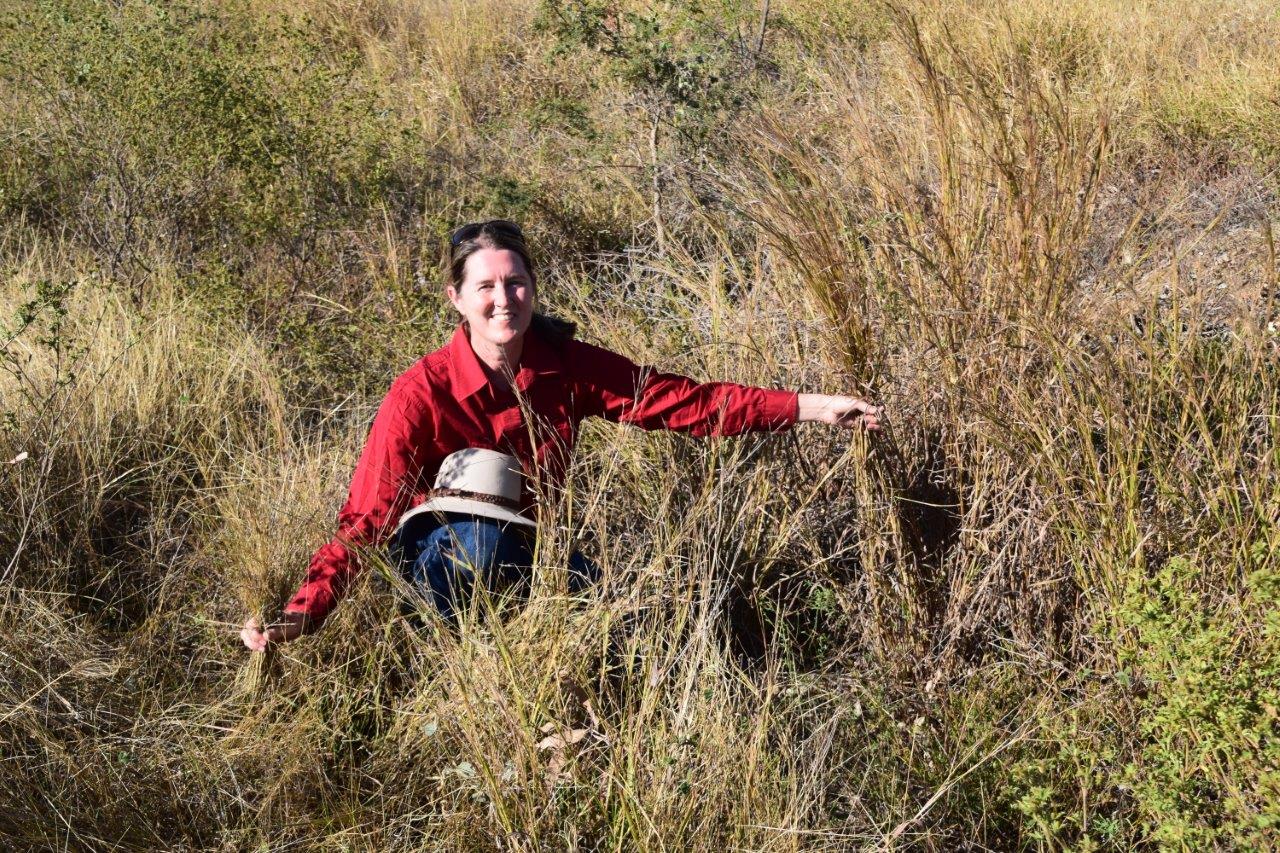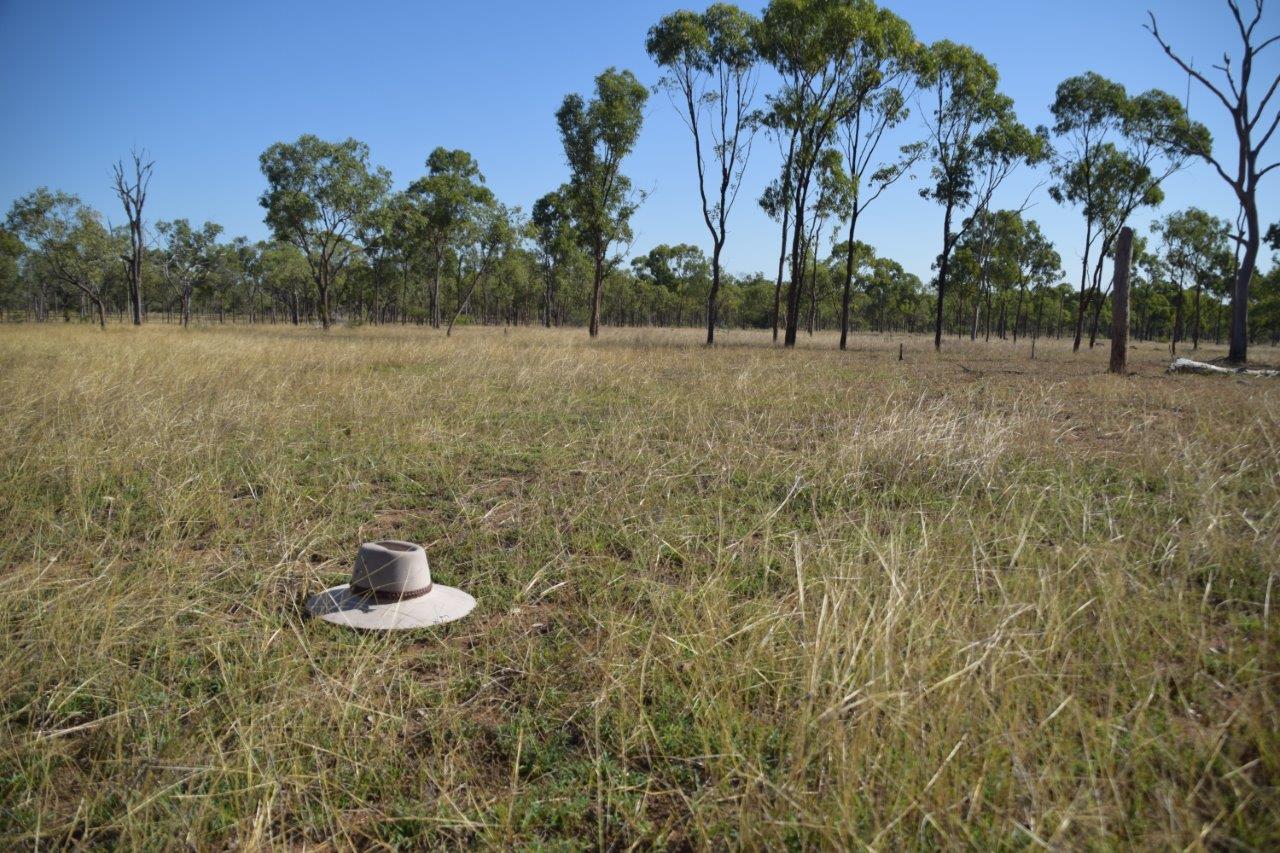Indian couch invasion: scope, production impacts, and management options
Rapid, widespread dominance of exotic, stoloniferous, perennial grass Indian couch (Bothriochloa pertusa) is occurring in Queensland pastures, with reports also for the Northern Territory. This transformation is not necessarily due to overgrazing, but nonetheless may lead to a 50% decline in productivity and resilience in beef grazing systems, and be associated with ecological penalties such as increased sediment run-off to the Great Barrier Reef lagoon and a decline in biodiversity. Despite several early introductions into Australia in the 1930s, and subsequent rapid spread of a less desirable strain noted in Queensland in the 1960s, there is relatively little information on the ecology, management and economics of Indian couch.
A Research and Development project jointly funded by Meat and Livestock Australia and the Department of Agriculture and Fisheries is now officially underway. Preceding this was a scoping study that commenced in 2015 that allowed agency staff and producer engagement to occur to achieve a better understanding of the Indian couch invasion across different catchments and under different circumstances. In Queensland, the catchments in focus were the Burdekin, Fitzroy and Burnett-Mary. From this earlier consultation, the research gaps and priorities were realised and the specifications for comprehensive RD&E were determined:
- Mapping the extent of Indian couch invasion,
- Understanding the drivers of invasion,
- Quantifying both landscape function and production impacts, and
- Developing the different guidelines required for managing Indian couch monocultures; halting or reversing Indian couch invasions; and options for targeted elimination of Indian couch.



Background
The issue:
The exotic, stoloniferous grass Indian couch (Bothriochloa pertusa), also known as Indian bluegrass, was introduced in the 1930’s but has now spread extensively through parts of Queensland. Producers are increasingly concerned that Indian couch invasion is having a significant, negative impact upon productivity and profitability through reduced forage production and poor drought tolerance, reduced animal performance and a heavier reliance on supplements (Spiegel, 2016). The ability of Indian couch to invade pastures and form monocultures is also of major concern, as is its potential adverse effects on soil health, landscape function and the difficulties involved in restoring Indian couch dominated pastures to a more productive state.
What we know:
Although heavy grazing has been implicated as the major cause for the spread and dominance of Indian couch (McKeon et al., 2004; Walker and Weston, 1990), the limited available research suggests other factors are also involved (e.g. Howden, 1988; Scanlan et al., 1996a; Ash et al., 2001). Indeed, Howden (1988) predicted that because of its competitive advantages over native grasses, Indian couch would spread and persist allowing it to become a major community component over a wide range of grazing intensities. However, it is relatively unproductive and has reduced drought tolerance compared with perennial tussock grasses, and therefore is an unreliable feed source in a highly variable climate.
While Indian couch has long dominated granodiorite landscapes in the Burdekin catchment, extensive invasion has also recently occurred throughout the more productive basalt landtypes of north Queensland (Stacey, 2014). Producers in central Queensland have also reported more recent invasion into planted buffel pastures. In the Northern Territory, there are reports of invasion into minimally disturbed, good condition pastures (Dionne Walsh, personal communication). Very little is known overseas about Indian couch invasion in pastures, although recent localised infestations have been reported in America (Diamond et al., 2013) and there have been reports of possible allelopathic effects of Indian couch (Hussain et al., 2010), i.e. plant inhibitory effects.
Producer feedback:
At the consultative workshops, producers noted that Indian couch invasion often starts off as isolated patches but can then spread rapidly; “can go from serviette to table size in a year”. Heavy grazing and drought were indicated as major contributing factors, primarily through compromising the competiveness of desired species, and allowing Indian couch to establish and spread. Prolonged rain was also identified as a problem in planted pastures, where buffel does not tolerate excessive waterlogging. Here again, a setback to the preferred grass species may provide an opportunity for Indian couch to invade, and Indian couch tolerates inundation.
In the sown buffel pastures of central Queensland, Indian couch is regarded as a weed, with producers favouring complete eradication. In contrast, on the granodiorite land types of north Queensland where monocultures already exist, producers emphasised that Indian couch was their sole forage source; “It is our value”. Removal in this situation, or failure to manage for droughts, would reduce cover and increase soil erosion and weeds. It is thus essential that context-specific management guidelines are developed to ensure that the appropriate objectives are achieved.
What are the gaps:
An important first step will be determining the geographical scope of Indian couch spread in pastures, and investigating rates and drivers of spread. While Indian couch is known to have spread extensively, its current geographical spread, dominance and potential area of spread are unknown. In 1990 the estimated invasion area in north-east Queensland was 800 000 ha (Walker and Weston, 1990). However, current estimates suggest an area of 11 million ha could be affected, with further range expansion very likely (Chris Holloway, personal communication). Extensive road survey work will be used to provide current mapping of Indian couch occurrence. A resurvey of historical sites on properties will also be carried out to investigate rates of change and factors influencing Indian couch spread on properties.
There has been only one study on the impacts of Indian couch on animal production (Jones, 1997). In this study, Indian couch did not reduce steer performance when compared to native pasture at moderate and high stocking rates. These results are not consistent with producer experience, probably because oversowing a relatively intact native pasture with Indian couch as done by Jones (1997) is markedly different Indian couch invasion of an overgrazed or bare paddock. The land condition and species effects on productivity thus need to be considered in conjunction with each other. An increase in Indian couch dominance may often be a symptom of previous poor management and landscape function decline. As a producer noted “the thing about Indian couch is the system has broken down well before the Indian couch invasion, and allowed for Indian couch to come in”. Although Scanlan et al., (1996b) reported that Indian couch reduced run-off and soil loss relative to native tussock grasses, this is at variance with the results of a recent longer, larger scale study which emphasised the critical role of deeper rooted, tussock grasses in reducing runoff (Bartley et al., 2014). There is therefore an opportunity to build on existing data to quantify both production and landscape function impacts associated with Indian couch in pastures.
Similarly, while there is evidence to suggest heavy grazing pressure may exacerbate the rate of Indian couch invasion in pastures, it is not known if management strategies such as prescribed burning, spelling and the introduction of more productive pasture species can be used to halt or reverse the process. For sown pastures, it is also not known if herbicides and/or cultivation are viable options for reducing the soil seedbanks and hence spread. A better understanding of the plant, its biology and the drivers of invasion would provide a platform of knowledge to inform the development of management options and direct future research, development and adoption.
Research significance:
Further deterioration of the feedbase through Indian couch invasion is of major economic and ecological concern. Indian couch dominated landscapes are probably running at well below the productive potential and are far more vulnerable to climate variability than the original systems. Monocultures are moreover, inherently unstable and susceptible to collapse through disease or pests, as happened when Townsville stylo dominated pastures in north Queensland were devastated by anthracnose. Adaptation of ecosystems to climate change will also be more difficult with single species or simplified ‘novel’ systems. Lastly, the increased runoff resulting from reduced landscape function with Indian couch dominated systems (Bartley et al., 2014) will only continue to have major adverse effects on reef water quality and erode the social licence of the extensive grazing industry.
Project components and significance
This project will take a two-stage approach:
Project Phase 1 (Current Phase, 2018-2022)
- Determine the extent, rate of spread, and likely spread of Indian couch invasion in north and central Queensland and in the Burnett-Mary.
- Identify the factors responsible for its expansion.
- Quantify the impacts of Indian couch on carrying capacity, livestock production and landscape function.
Project Phase 2
- Test and identify practical options to either manage or control its spread on native and sown pastures.
Summary
In summary, this project will quantify the extent of Indian couch invasion, its impacts on animal production and carrying capacity, and help producers manage this grass to increase their carrying capacity and improve pasture resilience. The production benefits from reversing Indian couch where levels are low, or in controlling Indian couch where cultivation is feasible and practiced, can be expected to offset costs. Only once the production impacts have been quantified and the specific management and control options for Indian couch identified, can the actual costs/benefits be quantified. However, for well-established Indian couch monocultures, where complete land restoration might be less likely, options for learning to live with Indian couch may need to be identified.
Project partners
This project has been jointly funded by the Department of Agriculture and Fisheries, Queensland Government and Meat and Livestock Australia.
Contact for the Indian couch project
Nicole Spiegel, Grazing Land Management Scientist, Department of Agriculture and Fisheries, Charters Towers, Queensland: phone: 0436 951 988, email: Nicole.Spiegel@daf.qld.gov.au
Further reading
Ash, A., Corfield, J. and Ksiksi, T (2001). The Ecograze Project: developing guidelines to better manage grazing country. Townprint Townsville.
Bartley, R., Corfield, J.P., Hawdon, A.A., Kinsey-Henderson, A.E., Abbot, B.N., Wilkinson, S.N. and Keen, R.J. (2014). Can changes to pasture management reduce runoff and sediment loss to the Great Barrier Reef? The results of a 10-year study in the Burdekin catchment, Australia. The Rangeland Journal, 36, 67-84.
Diamond, A.R., England, J.K., and Dykes, B. (2013). New to Alabama: Pitted bluestem, Bothriochloa pertusa (Poaceae). Phytoneuron, 40, 1-5.
Howden, S.M. (1988). Some aspects of the ecology of four tropical grasses with special emphasis on Bothriochloa pertusa. PhD thesis, Griffith University.
Hussain, F., Ahmad, B., and Ilahi, I. (2010). Allelopathic effects of Cenchrus ciliaris L. and Bothriochloa pertusa (L.) A. Camus. Pakistan Journal of Botany, 42(5), 3587-3604.
Jones, R.J. (1997). Steer gains, pasture yield and pasture composition on native pasture and on native pasture oversown with Indian couch (Bothriochloa pertusa) at three stocking rates. Australian Journal of Experimental Agriculture, 37, 755-65.
McKeon, G., Hall, W., Henry, B., Stone, G. and Watson, I. (2004). Pasture degradation and recovery in Australia’s rangelands: Learning from history. The State of Queensland, Department of Natural Resources, Mines and Energy
Scanlan, J.C., Pressland, A.J. and Myles, D.J. (1996a). Grazing modifies woody and herbaceous components of north Queensland woodlands. The Rangeland Journal, 18(1), 47-57.
Scanlan, J.C., Pressland, A.J. and Myles, D.J. (1996b). Run-off and soil movement on mid-slopes in north-east Queensland grazed woodlands. The Rangeland Journal, 18(1), 33-46.
Stacey, R. (2014). Is Bothriochloa pertusa increasing in the Basalt land types of the Dalrymple region? Master’s thesis. The University of Queensland, Gatton.
Spiegel, N. (2016). Developing an RD&E project to address loss of productivity in Queensland pastures invaded by Indian couch (Bothriochloa pertusa). Project Report. State of Queensland.
Walker, B. and Weston, E.J. (1990). Pasture development in Queensland – A success story. Tropical Grasslands, 24, 257-268.